Report: Analyzing Social Media Communication in the Workplace
VerifiedAdded on 2023/01/09
|8
|2265
|28
Report
AI Summary
This report analyzes the use of social media as a communication tool within organizations, drawing on peer-reviewed literature. It explores the benefits, such as cost-effective communication, especially for geographically dispersed teams, and increased employee engagement due to frequent social media use. The report examines studies on the correlation between social media use and job satisfaction, highlighting the impact of platforms like Facebook. It also discusses barriers to communication, including lack of trust and changing organizational behaviors, while emphasizing the need for clear social media policies. The analysis covers the use of social media for crisis communication, internal communication, and knowledge sharing, and considers alternative platforms like team communication platforms. The report concludes that while social media offers significant advantages, organizations must develop clear strategies and frameworks to maximize its effectiveness, particularly for successive generations. References from various authors are provided to support the findings.
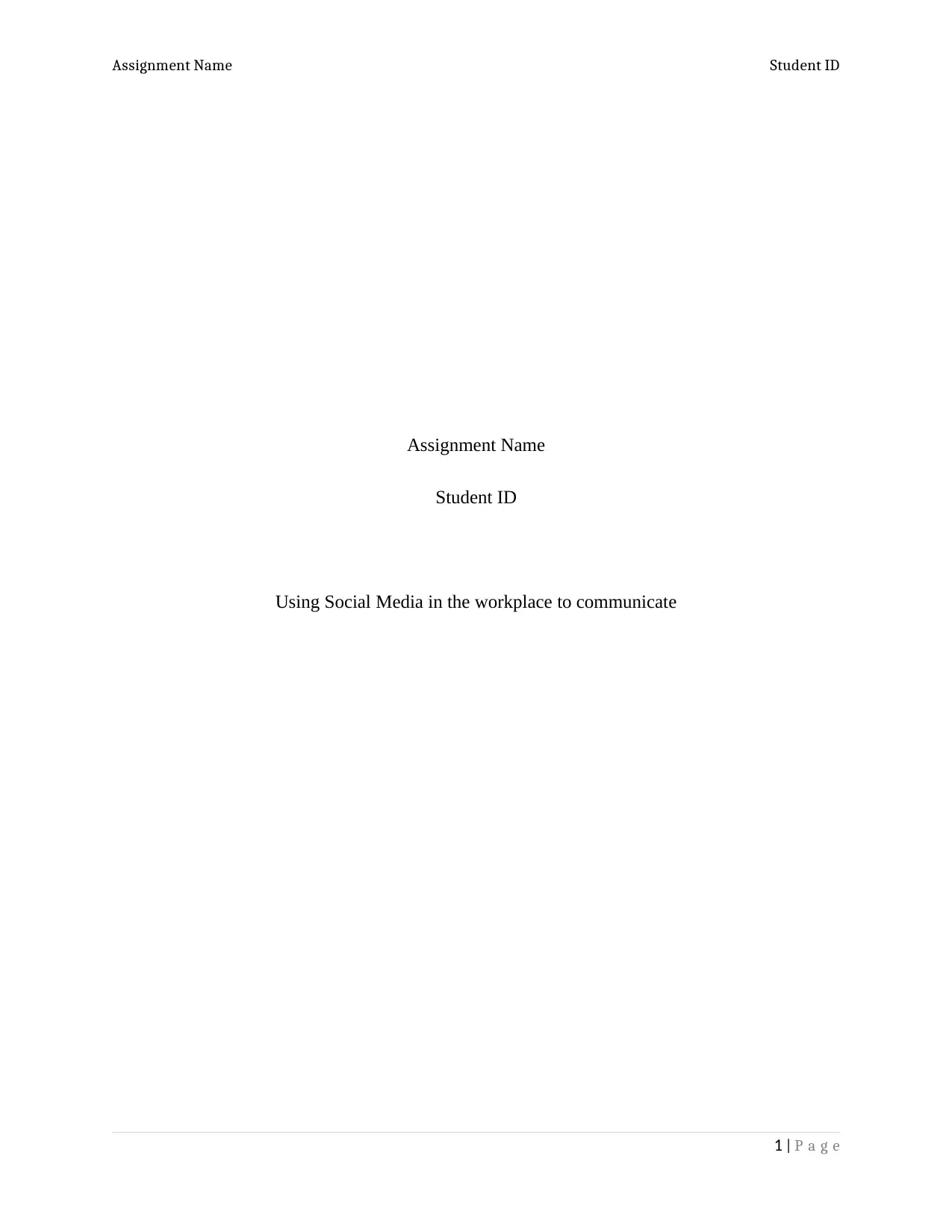
Assignment Name Student ID
Assignment Name
Student ID
Using Social Media in the workplace to communicate
1 | P a g e
Assignment Name
Student ID
Using Social Media in the workplace to communicate
1 | P a g e
Paraphrase This Document
Need a fresh take? Get an instant paraphrase of this document with our AI Paraphraser
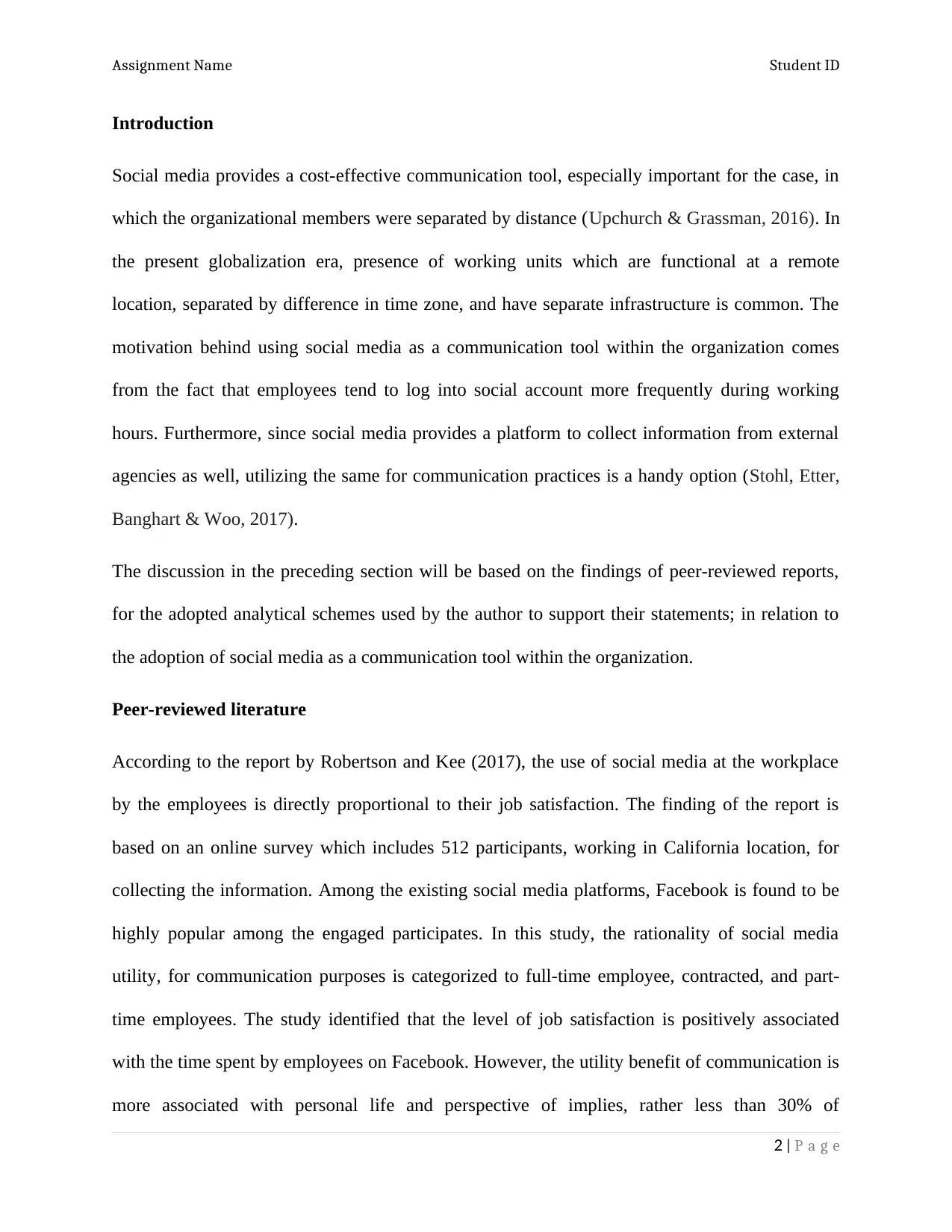
Assignment Name Student ID
Introduction
Social media provides a cost-effective communication tool, especially important for the case, in
which the organizational members were separated by distance (Upchurch & Grassman, 2016). In
the present globalization era, presence of working units which are functional at a remote
location, separated by difference in time zone, and have separate infrastructure is common. The
motivation behind using social media as a communication tool within the organization comes
from the fact that employees tend to log into social account more frequently during working
hours. Furthermore, since social media provides a platform to collect information from external
agencies as well, utilizing the same for communication practices is a handy option (Stohl, Etter,
Banghart & Woo, 2017).
The discussion in the preceding section will be based on the findings of peer-reviewed reports,
for the adopted analytical schemes used by the author to support their statements; in relation to
the adoption of social media as a communication tool within the organization.
Peer-reviewed literature
According to the report by Robertson and Kee (2017), the use of social media at the workplace
by the employees is directly proportional to their job satisfaction. The finding of the report is
based on an online survey which includes 512 participants, working in California location, for
collecting the information. Among the existing social media platforms, Facebook is found to be
highly popular among the engaged participates. In this study, the rationality of social media
utility, for communication purposes is categorized to full-time employee, contracted, and part-
time employees. The study identified that the level of job satisfaction is positively associated
with the time spent by employees on Facebook. However, the utility benefit of communication is
more associated with personal life and perspective of implies, rather less than 30% of
2 | P a g e
Introduction
Social media provides a cost-effective communication tool, especially important for the case, in
which the organizational members were separated by distance (Upchurch & Grassman, 2016). In
the present globalization era, presence of working units which are functional at a remote
location, separated by difference in time zone, and have separate infrastructure is common. The
motivation behind using social media as a communication tool within the organization comes
from the fact that employees tend to log into social account more frequently during working
hours. Furthermore, since social media provides a platform to collect information from external
agencies as well, utilizing the same for communication practices is a handy option (Stohl, Etter,
Banghart & Woo, 2017).
The discussion in the preceding section will be based on the findings of peer-reviewed reports,
for the adopted analytical schemes used by the author to support their statements; in relation to
the adoption of social media as a communication tool within the organization.
Peer-reviewed literature
According to the report by Robertson and Kee (2017), the use of social media at the workplace
by the employees is directly proportional to their job satisfaction. The finding of the report is
based on an online survey which includes 512 participants, working in California location, for
collecting the information. Among the existing social media platforms, Facebook is found to be
highly popular among the engaged participates. In this study, the rationality of social media
utility, for communication purposes is categorized to full-time employee, contracted, and part-
time employees. The study identified that the level of job satisfaction is positively associated
with the time spent by employees on Facebook. However, the utility benefit of communication is
more associated with personal life and perspective of implies, rather less than 30% of
2 | P a g e
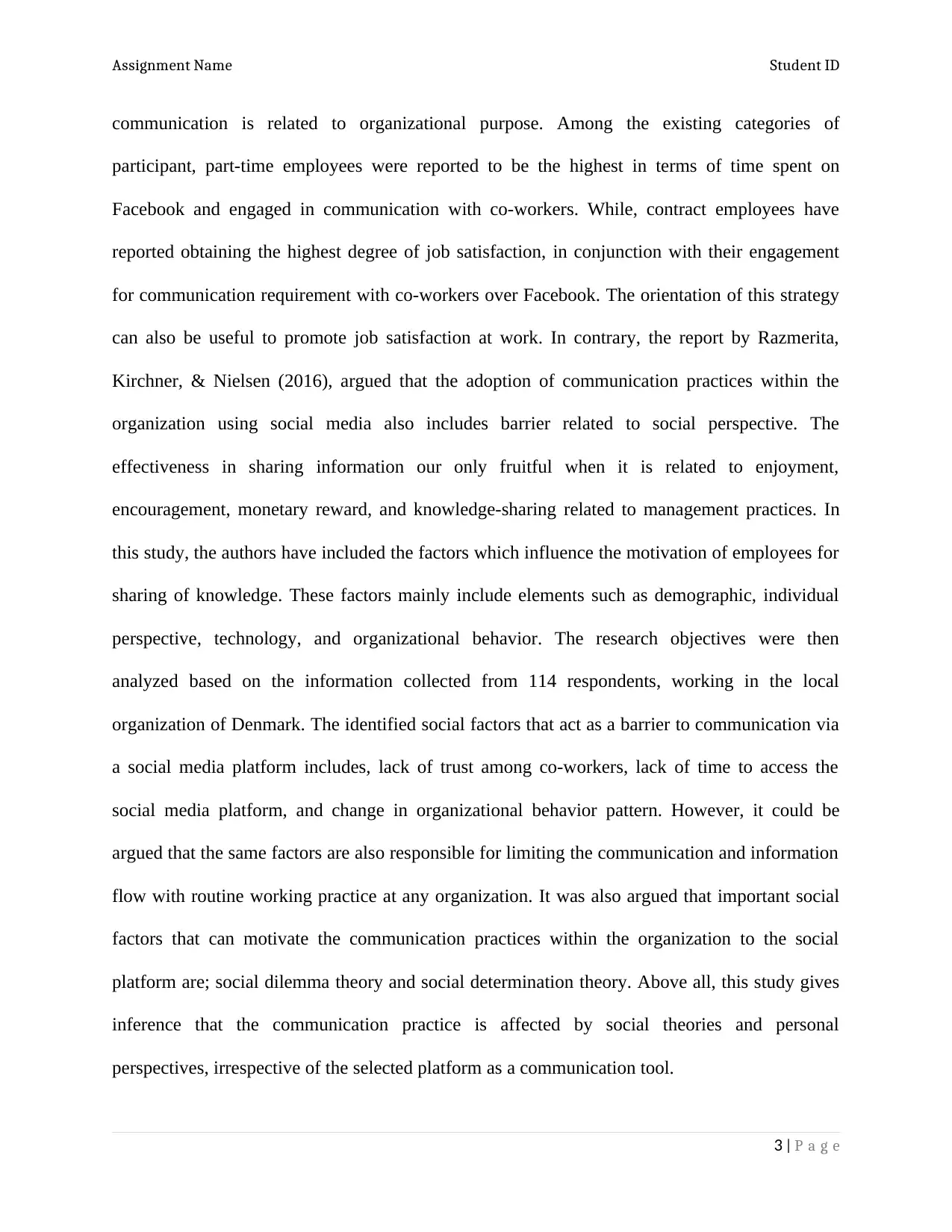
Assignment Name Student ID
communication is related to organizational purpose. Among the existing categories of
participant, part-time employees were reported to be the highest in terms of time spent on
Facebook and engaged in communication with co-workers. While, contract employees have
reported obtaining the highest degree of job satisfaction, in conjunction with their engagement
for communication requirement with co-workers over Facebook. The orientation of this strategy
can also be useful to promote job satisfaction at work. In contrary, the report by Razmerita,
Kirchner, & Nielsen (2016), argued that the adoption of communication practices within the
organization using social media also includes barrier related to social perspective. The
effectiveness in sharing information our only fruitful when it is related to enjoyment,
encouragement, monetary reward, and knowledge-sharing related to management practices. In
this study, the authors have included the factors which influence the motivation of employees for
sharing of knowledge. These factors mainly include elements such as demographic, individual
perspective, technology, and organizational behavior. The research objectives were then
analyzed based on the information collected from 114 respondents, working in the local
organization of Denmark. The identified social factors that act as a barrier to communication via
a social media platform includes, lack of trust among co-workers, lack of time to access the
social media platform, and change in organizational behavior pattern. However, it could be
argued that the same factors are also responsible for limiting the communication and information
flow with routine working practice at any organization. It was also argued that important social
factors that can motivate the communication practices within the organization to the social
platform are; social dilemma theory and social determination theory. Above all, this study gives
inference that the communication practice is affected by social theories and personal
perspectives, irrespective of the selected platform as a communication tool.
3 | P a g e
communication is related to organizational purpose. Among the existing categories of
participant, part-time employees were reported to be the highest in terms of time spent on
Facebook and engaged in communication with co-workers. While, contract employees have
reported obtaining the highest degree of job satisfaction, in conjunction with their engagement
for communication requirement with co-workers over Facebook. The orientation of this strategy
can also be useful to promote job satisfaction at work. In contrary, the report by Razmerita,
Kirchner, & Nielsen (2016), argued that the adoption of communication practices within the
organization using social media also includes barrier related to social perspective. The
effectiveness in sharing information our only fruitful when it is related to enjoyment,
encouragement, monetary reward, and knowledge-sharing related to management practices. In
this study, the authors have included the factors which influence the motivation of employees for
sharing of knowledge. These factors mainly include elements such as demographic, individual
perspective, technology, and organizational behavior. The research objectives were then
analyzed based on the information collected from 114 respondents, working in the local
organization of Denmark. The identified social factors that act as a barrier to communication via
a social media platform includes, lack of trust among co-workers, lack of time to access the
social media platform, and change in organizational behavior pattern. However, it could be
argued that the same factors are also responsible for limiting the communication and information
flow with routine working practice at any organization. It was also argued that important social
factors that can motivate the communication practices within the organization to the social
platform are; social dilemma theory and social determination theory. Above all, this study gives
inference that the communication practice is affected by social theories and personal
perspectives, irrespective of the selected platform as a communication tool.
3 | P a g e
⊘ This is a preview!⊘
Do you want full access?
Subscribe today to unlock all pages.

Trusted by 1+ million students worldwide
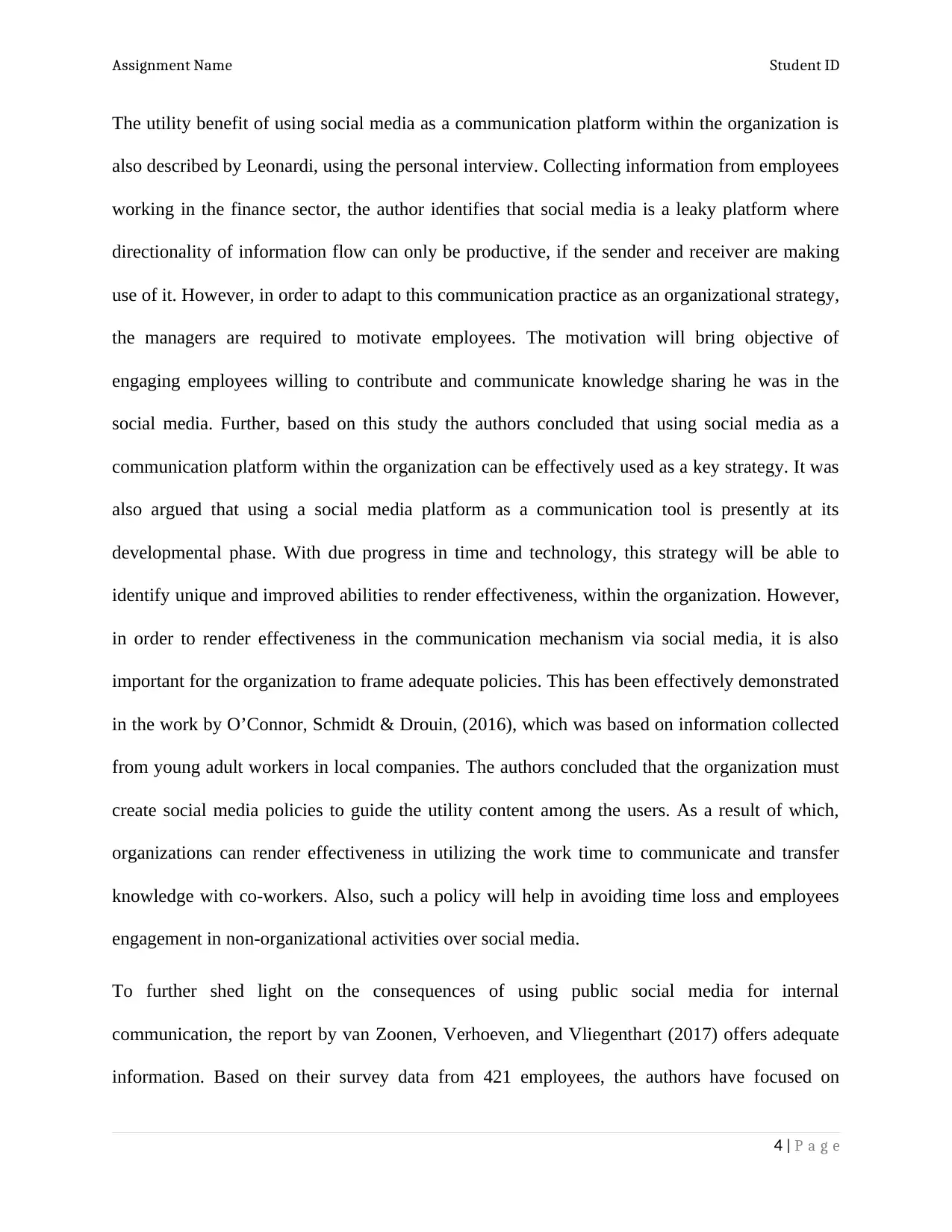
Assignment Name Student ID
The utility benefit of using social media as a communication platform within the organization is
also described by Leonardi, using the personal interview. Collecting information from employees
working in the finance sector, the author identifies that social media is a leaky platform where
directionality of information flow can only be productive, if the sender and receiver are making
use of it. However, in order to adapt to this communication practice as an organizational strategy,
the managers are required to motivate employees. The motivation will bring objective of
engaging employees willing to contribute and communicate knowledge sharing he was in the
social media. Further, based on this study the authors concluded that using social media as a
communication platform within the organization can be effectively used as a key strategy. It was
also argued that using a social media platform as a communication tool is presently at its
developmental phase. With due progress in time and technology, this strategy will be able to
identify unique and improved abilities to render effectiveness, within the organization. However,
in order to render effectiveness in the communication mechanism via social media, it is also
important for the organization to frame adequate policies. This has been effectively demonstrated
in the work by O’Connor, Schmidt & Drouin, (2016), which was based on information collected
from young adult workers in local companies. The authors concluded that the organization must
create social media policies to guide the utility content among the users. As a result of which,
organizations can render effectiveness in utilizing the work time to communicate and transfer
knowledge with co-workers. Also, such a policy will help in avoiding time loss and employees
engagement in non-organizational activities over social media.
To further shed light on the consequences of using public social media for internal
communication, the report by van Zoonen, Verhoeven, and Vliegenthart (2017) offers adequate
information. Based on their survey data from 421 employees, the authors have focused on
4 | P a g e
The utility benefit of using social media as a communication platform within the organization is
also described by Leonardi, using the personal interview. Collecting information from employees
working in the finance sector, the author identifies that social media is a leaky platform where
directionality of information flow can only be productive, if the sender and receiver are making
use of it. However, in order to adapt to this communication practice as an organizational strategy,
the managers are required to motivate employees. The motivation will bring objective of
engaging employees willing to contribute and communicate knowledge sharing he was in the
social media. Further, based on this study the authors concluded that using social media as a
communication platform within the organization can be effectively used as a key strategy. It was
also argued that using a social media platform as a communication tool is presently at its
developmental phase. With due progress in time and technology, this strategy will be able to
identify unique and improved abilities to render effectiveness, within the organization. However,
in order to render effectiveness in the communication mechanism via social media, it is also
important for the organization to frame adequate policies. This has been effectively demonstrated
in the work by O’Connor, Schmidt & Drouin, (2016), which was based on information collected
from young adult workers in local companies. The authors concluded that the organization must
create social media policies to guide the utility content among the users. As a result of which,
organizations can render effectiveness in utilizing the work time to communicate and transfer
knowledge with co-workers. Also, such a policy will help in avoiding time loss and employees
engagement in non-organizational activities over social media.
To further shed light on the consequences of using public social media for internal
communication, the report by van Zoonen, Verhoeven, and Vliegenthart (2017) offers adequate
information. Based on their survey data from 421 employees, the authors have focused on
4 | P a g e
Paraphrase This Document
Need a fresh take? Get an instant paraphrase of this document with our AI Paraphraser
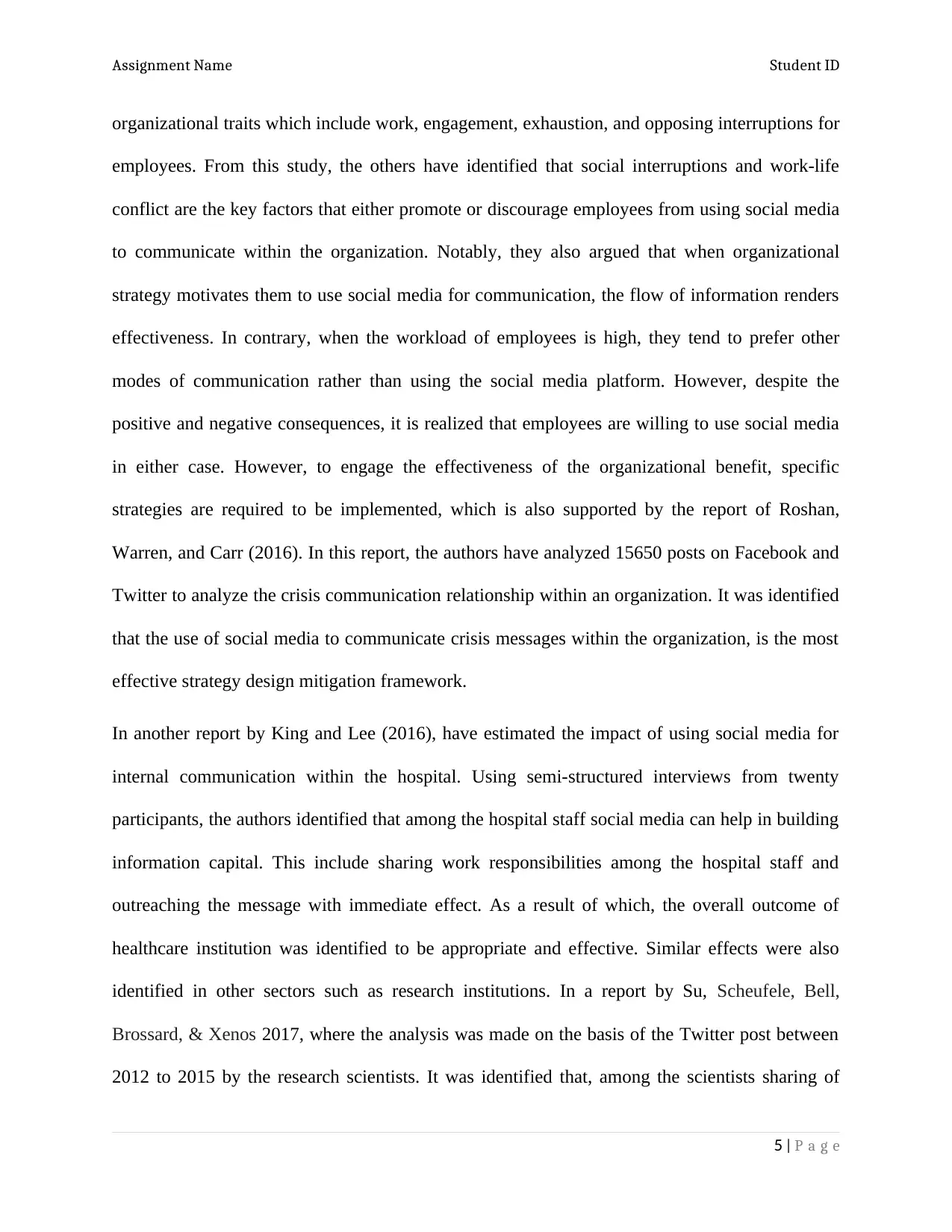
Assignment Name Student ID
organizational traits which include work, engagement, exhaustion, and opposing interruptions for
employees. From this study, the others have identified that social interruptions and work-life
conflict are the key factors that either promote or discourage employees from using social media
to communicate within the organization. Notably, they also argued that when organizational
strategy motivates them to use social media for communication, the flow of information renders
effectiveness. In contrary, when the workload of employees is high, they tend to prefer other
modes of communication rather than using the social media platform. However, despite the
positive and negative consequences, it is realized that employees are willing to use social media
in either case. However, to engage the effectiveness of the organizational benefit, specific
strategies are required to be implemented, which is also supported by the report of Roshan,
Warren, and Carr (2016). In this report, the authors have analyzed 15650 posts on Facebook and
Twitter to analyze the crisis communication relationship within an organization. It was identified
that the use of social media to communicate crisis messages within the organization, is the most
effective strategy design mitigation framework.
In another report by King and Lee (2016), have estimated the impact of using social media for
internal communication within the hospital. Using semi-structured interviews from twenty
participants, the authors identified that among the hospital staff social media can help in building
information capital. This include sharing work responsibilities among the hospital staff and
outreaching the message with immediate effect. As a result of which, the overall outcome of
healthcare institution was identified to be appropriate and effective. Similar effects were also
identified in other sectors such as research institutions. In a report by Su, Scheufele, Bell,
Brossard, & Xenos 2017, where the analysis was made on the basis of the Twitter post between
2012 to 2015 by the research scientists. It was identified that, among the scientists sharing of
5 | P a g e
organizational traits which include work, engagement, exhaustion, and opposing interruptions for
employees. From this study, the others have identified that social interruptions and work-life
conflict are the key factors that either promote or discourage employees from using social media
to communicate within the organization. Notably, they also argued that when organizational
strategy motivates them to use social media for communication, the flow of information renders
effectiveness. In contrary, when the workload of employees is high, they tend to prefer other
modes of communication rather than using the social media platform. However, despite the
positive and negative consequences, it is realized that employees are willing to use social media
in either case. However, to engage the effectiveness of the organizational benefit, specific
strategies are required to be implemented, which is also supported by the report of Roshan,
Warren, and Carr (2016). In this report, the authors have analyzed 15650 posts on Facebook and
Twitter to analyze the crisis communication relationship within an organization. It was identified
that the use of social media to communicate crisis messages within the organization, is the most
effective strategy design mitigation framework.
In another report by King and Lee (2016), have estimated the impact of using social media for
internal communication within the hospital. Using semi-structured interviews from twenty
participants, the authors identified that among the hospital staff social media can help in building
information capital. This include sharing work responsibilities among the hospital staff and
outreaching the message with immediate effect. As a result of which, the overall outcome of
healthcare institution was identified to be appropriate and effective. Similar effects were also
identified in other sectors such as research institutions. In a report by Su, Scheufele, Bell,
Brossard, & Xenos 2017, where the analysis was made on the basis of the Twitter post between
2012 to 2015 by the research scientists. It was identified that, among the scientists sharing of
5 | P a g e
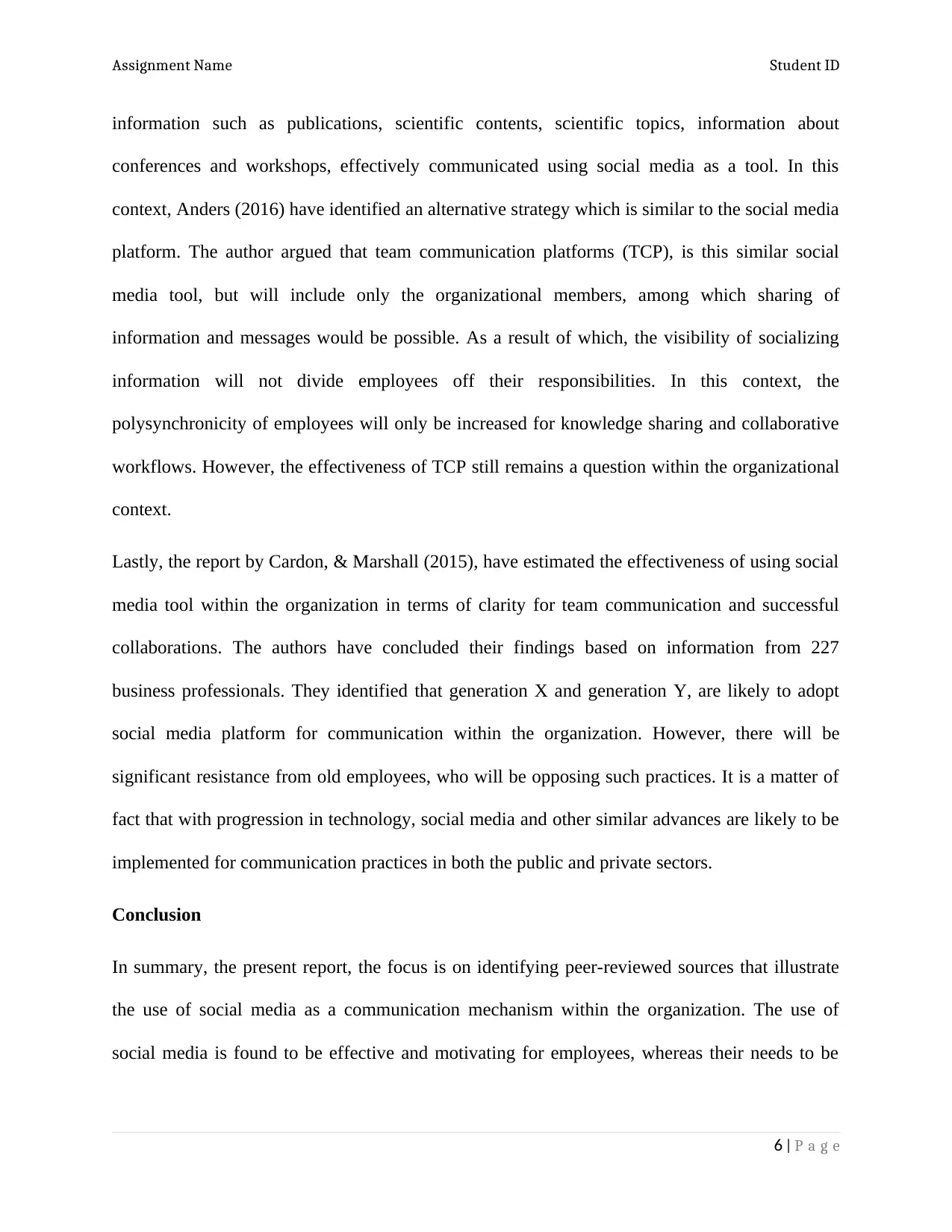
Assignment Name Student ID
information such as publications, scientific contents, scientific topics, information about
conferences and workshops, effectively communicated using social media as a tool. In this
context, Anders (2016) have identified an alternative strategy which is similar to the social media
platform. The author argued that team communication platforms (TCP), is this similar social
media tool, but will include only the organizational members, among which sharing of
information and messages would be possible. As a result of which, the visibility of socializing
information will not divide employees off their responsibilities. In this context, the
polysynchronicity of employees will only be increased for knowledge sharing and collaborative
workflows. However, the effectiveness of TCP still remains a question within the organizational
context.
Lastly, the report by Cardon, & Marshall (2015), have estimated the effectiveness of using social
media tool within the organization in terms of clarity for team communication and successful
collaborations. The authors have concluded their findings based on information from 227
business professionals. They identified that generation X and generation Y, are likely to adopt
social media platform for communication within the organization. However, there will be
significant resistance from old employees, who will be opposing such practices. It is a matter of
fact that with progression in technology, social media and other similar advances are likely to be
implemented for communication practices in both the public and private sectors.
Conclusion
In summary, the present report, the focus is on identifying peer-reviewed sources that illustrate
the use of social media as a communication mechanism within the organization. The use of
social media is found to be effective and motivating for employees, whereas their needs to be
6 | P a g e
information such as publications, scientific contents, scientific topics, information about
conferences and workshops, effectively communicated using social media as a tool. In this
context, Anders (2016) have identified an alternative strategy which is similar to the social media
platform. The author argued that team communication platforms (TCP), is this similar social
media tool, but will include only the organizational members, among which sharing of
information and messages would be possible. As a result of which, the visibility of socializing
information will not divide employees off their responsibilities. In this context, the
polysynchronicity of employees will only be increased for knowledge sharing and collaborative
workflows. However, the effectiveness of TCP still remains a question within the organizational
context.
Lastly, the report by Cardon, & Marshall (2015), have estimated the effectiveness of using social
media tool within the organization in terms of clarity for team communication and successful
collaborations. The authors have concluded their findings based on information from 227
business professionals. They identified that generation X and generation Y, are likely to adopt
social media platform for communication within the organization. However, there will be
significant resistance from old employees, who will be opposing such practices. It is a matter of
fact that with progression in technology, social media and other similar advances are likely to be
implemented for communication practices in both the public and private sectors.
Conclusion
In summary, the present report, the focus is on identifying peer-reviewed sources that illustrate
the use of social media as a communication mechanism within the organization. The use of
social media is found to be effective and motivating for employees, whereas their needs to be
6 | P a g e
⊘ This is a preview!⊘
Do you want full access?
Subscribe today to unlock all pages.

Trusted by 1+ million students worldwide
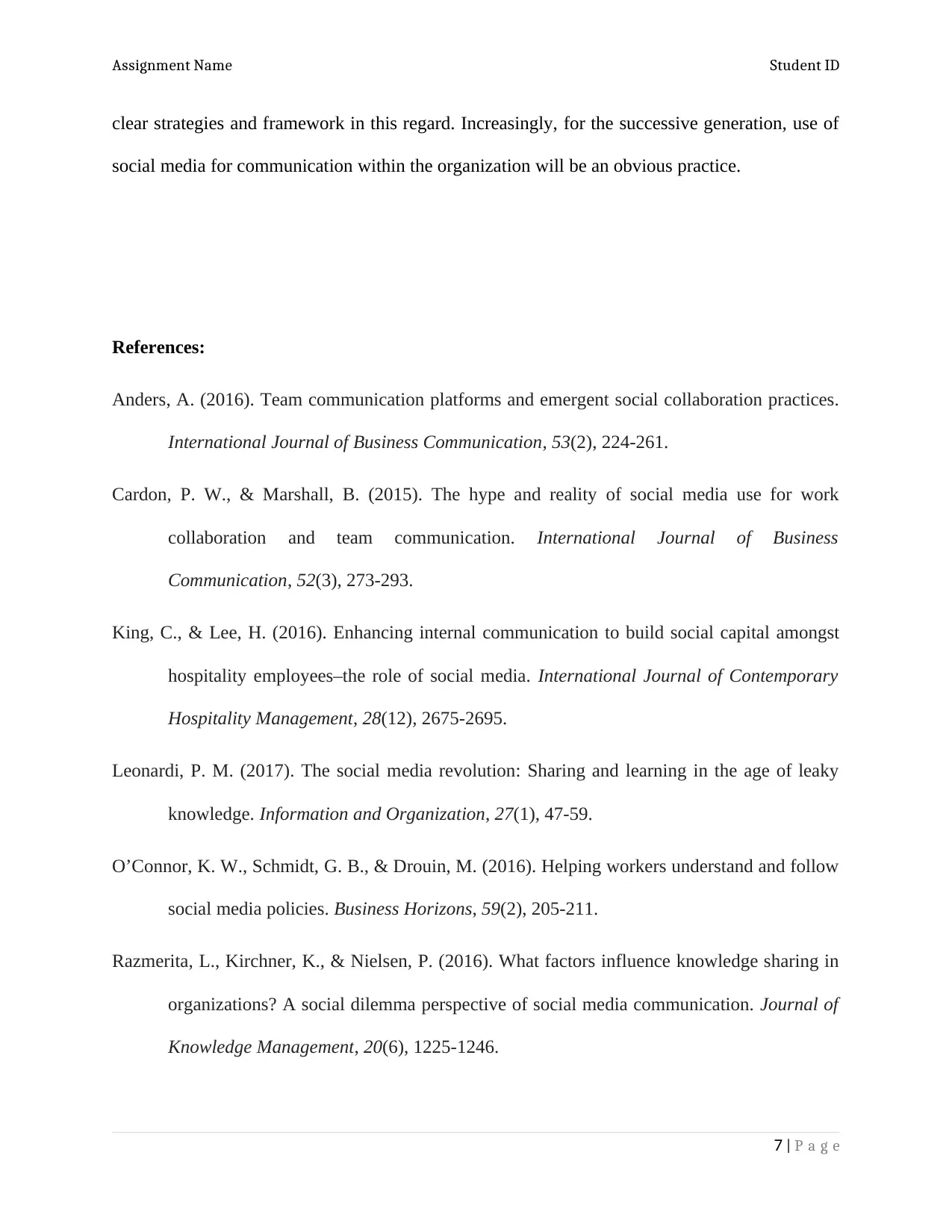
Assignment Name Student ID
clear strategies and framework in this regard. Increasingly, for the successive generation, use of
social media for communication within the organization will be an obvious practice.
References:
Anders, A. (2016). Team communication platforms and emergent social collaboration practices.
International Journal of Business Communication, 53(2), 224-261.
Cardon, P. W., & Marshall, B. (2015). The hype and reality of social media use for work
collaboration and team communication. International Journal of Business
Communication, 52(3), 273-293.
King, C., & Lee, H. (2016). Enhancing internal communication to build social capital amongst
hospitality employees–the role of social media. International Journal of Contemporary
Hospitality Management, 28(12), 2675-2695.
Leonardi, P. M. (2017). The social media revolution: Sharing and learning in the age of leaky
knowledge. Information and Organization, 27(1), 47-59.
O’Connor, K. W., Schmidt, G. B., & Drouin, M. (2016). Helping workers understand and follow
social media policies. Business Horizons, 59(2), 205-211.
Razmerita, L., Kirchner, K., & Nielsen, P. (2016). What factors influence knowledge sharing in
organizations? A social dilemma perspective of social media communication. Journal of
Knowledge Management, 20(6), 1225-1246.
7 | P a g e
clear strategies and framework in this regard. Increasingly, for the successive generation, use of
social media for communication within the organization will be an obvious practice.
References:
Anders, A. (2016). Team communication platforms and emergent social collaboration practices.
International Journal of Business Communication, 53(2), 224-261.
Cardon, P. W., & Marshall, B. (2015). The hype and reality of social media use for work
collaboration and team communication. International Journal of Business
Communication, 52(3), 273-293.
King, C., & Lee, H. (2016). Enhancing internal communication to build social capital amongst
hospitality employees–the role of social media. International Journal of Contemporary
Hospitality Management, 28(12), 2675-2695.
Leonardi, P. M. (2017). The social media revolution: Sharing and learning in the age of leaky
knowledge. Information and Organization, 27(1), 47-59.
O’Connor, K. W., Schmidt, G. B., & Drouin, M. (2016). Helping workers understand and follow
social media policies. Business Horizons, 59(2), 205-211.
Razmerita, L., Kirchner, K., & Nielsen, P. (2016). What factors influence knowledge sharing in
organizations? A social dilemma perspective of social media communication. Journal of
Knowledge Management, 20(6), 1225-1246.
7 | P a g e
Paraphrase This Document
Need a fresh take? Get an instant paraphrase of this document with our AI Paraphraser
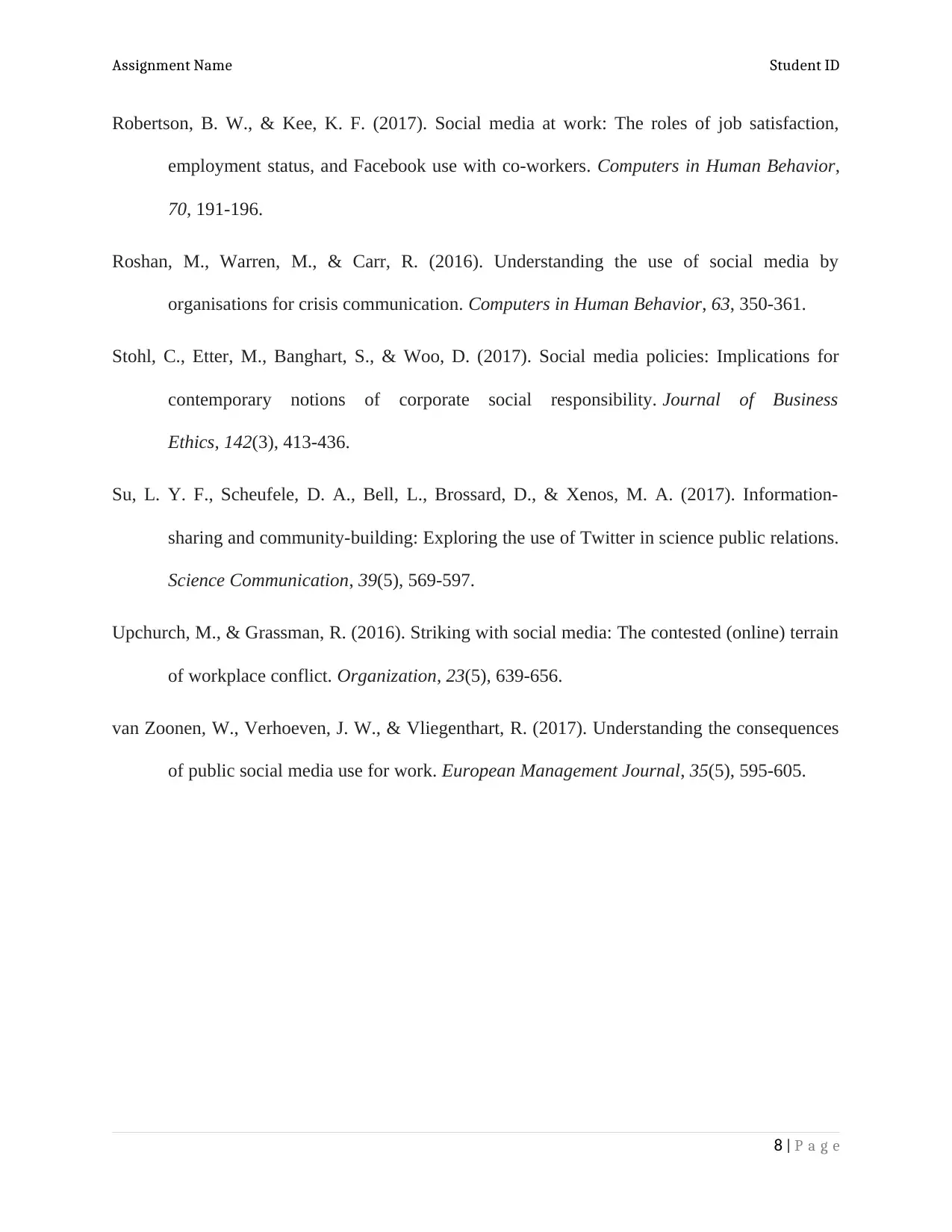
Assignment Name Student ID
Robertson, B. W., & Kee, K. F. (2017). Social media at work: The roles of job satisfaction,
employment status, and Facebook use with co-workers. Computers in Human Behavior,
70, 191-196.
Roshan, M., Warren, M., & Carr, R. (2016). Understanding the use of social media by
organisations for crisis communication. Computers in Human Behavior, 63, 350-361.
Stohl, C., Etter, M., Banghart, S., & Woo, D. (2017). Social media policies: Implications for
contemporary notions of corporate social responsibility. Journal of Business
Ethics, 142(3), 413-436.
Su, L. Y. F., Scheufele, D. A., Bell, L., Brossard, D., & Xenos, M. A. (2017). Information-
sharing and community-building: Exploring the use of Twitter in science public relations.
Science Communication, 39(5), 569-597.
Upchurch, M., & Grassman, R. (2016). Striking with social media: The contested (online) terrain
of workplace conflict. Organization, 23(5), 639-656.
van Zoonen, W., Verhoeven, J. W., & Vliegenthart, R. (2017). Understanding the consequences
of public social media use for work. European Management Journal, 35(5), 595-605.
8 | P a g e
Robertson, B. W., & Kee, K. F. (2017). Social media at work: The roles of job satisfaction,
employment status, and Facebook use with co-workers. Computers in Human Behavior,
70, 191-196.
Roshan, M., Warren, M., & Carr, R. (2016). Understanding the use of social media by
organisations for crisis communication. Computers in Human Behavior, 63, 350-361.
Stohl, C., Etter, M., Banghart, S., & Woo, D. (2017). Social media policies: Implications for
contemporary notions of corporate social responsibility. Journal of Business
Ethics, 142(3), 413-436.
Su, L. Y. F., Scheufele, D. A., Bell, L., Brossard, D., & Xenos, M. A. (2017). Information-
sharing and community-building: Exploring the use of Twitter in science public relations.
Science Communication, 39(5), 569-597.
Upchurch, M., & Grassman, R. (2016). Striking with social media: The contested (online) terrain
of workplace conflict. Organization, 23(5), 639-656.
van Zoonen, W., Verhoeven, J. W., & Vliegenthart, R. (2017). Understanding the consequences
of public social media use for work. European Management Journal, 35(5), 595-605.
8 | P a g e
1 out of 8
Related Documents
Your All-in-One AI-Powered Toolkit for Academic Success.
+13062052269
info@desklib.com
Available 24*7 on WhatsApp / Email
![[object Object]](/_next/static/media/star-bottom.7253800d.svg)
Unlock your academic potential
Copyright © 2020–2025 A2Z Services. All Rights Reserved. Developed and managed by ZUCOL.




